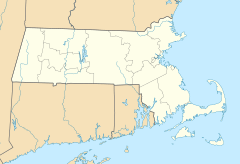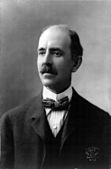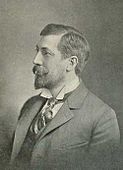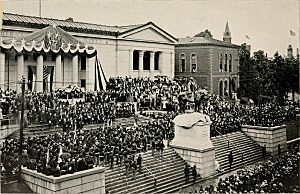Equestrian statue of Charles Devens facts for kids
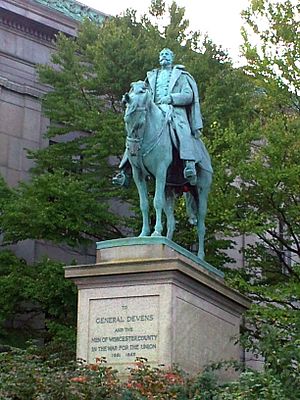
Charles Devens statue (2011)
|
|
| Coordinates | 42°16′16″N 71°48′00″W / 42.27111°N 71.80000°W |
|---|---|
| Location | Institutional District, Worcester, Massachusetts, United States |
| Designer | Daniel Chester French Edward Clark Potter Robert D. Andrews (pedestal) |
| Builder | Gorham Manufacturing Company George D. Webb Granite and Construction Co. (pedestal) Jno. Williams, Inc. (plaque and lettering) |
| Type | Equestrian statue |
| Material | Bronze Granite (pedestal) |
| Width | 9.7 feet (3.0 m) |
| Height | 40.8 feet (12.4 m) |
| Beginning date | 1902 |
| Completion date | 1906 |
| Dedicated to | Charles Devens |
The equestrian statue of Charles Devens is a famous public monument in Worcester, Massachusetts. It stands in front of the old Worcester County Courthouse. This equestrian statue honors Charles Devens, a brave general who fought for the Union Army during the American Civil War. After the war, he became the United States Attorney General, a very important legal job for the country.
The statue was created by talented sculptors Daniel Chester French and Edward Clark Potter. It was officially revealed on July 4, 1906.
Contents
Discovering Charles Devens' Life
Who Was Charles Devens?
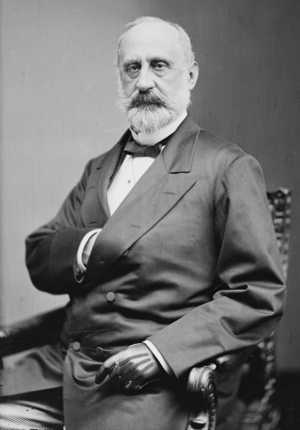
Charles Devens was born in Charlestown, Massachusetts, on April 4, 1820. He went to the Boston Latin School and later studied at Harvard College. In 1840, he earned a law degree from Harvard Law School. He started working as a lawyer in 1841.
Devens soon became involved in politics. He served in the Massachusetts Senate from 1848 to 1849. From 1849 to 1853, he was a United States marshal, a law enforcement officer.
Devens in the Civil War
During the American Civil War, Charles Devens joined the Union Army. He started as a major and later became a colonel. By the end of the war, he had earned the rank of general. He was wounded in two major battles: the Battle of Fair Oaks and the Battle of Chancellorsville.
After the war, Devens returned to his law career. In 1873, he became a judge for the Massachusetts Supreme Judicial Court. Then, in 1877, President Rutherford B. Hayes chose him to be the United States Attorney General. He held this important position until 1881. Charles Devens passed away in Boston on January 7, 1891.
Creating the Devens Statue
The Idea for a Monument
People wanted to honor Charles Devens with a monument after he died. In late 1891, United States Senator George Frisbie Hoar invited important citizens from Worcester to a meeting. They discussed building a statue and raising money for it.
Initially, the project didn't move forward quickly. But in 1901, a group of veterans from Devens' old regiment, the 15th Massachusetts Infantry, brought the idea back to life. In 1902, a larger committee was formed with many important local leaders.
Designing the Statue
The city of Worcester and Worcester County helped fund the statue. Other towns in the county also contributed money. In July 1902, the committee chose two famous sculptors: Daniel Chester French and Edward Clark Potter. They were asked to design an equestrian statue of Devens.
French was known for sculpting people, and Potter was an expert at sculpting horses. They had worked together on other statues before. In 1903, they showed a model of the statue, which the committee approved. An architect named Robert D. Andrews designed the pedestal (the base) for the statue.
The statue was cast in bronze by the Gorham Manufacturing Company in Providence, Rhode Island. Senator Hoar even arranged for old cannons to be used to make the bronze!
Unveiling the Statue
The Dedication Ceremony
By December 1905, the statue was almost finished. A committee planned a big ceremony for its dedication. They decided to place the monument in front of the Worcester County Court House.
The unveiling happened on July 4, 1906. About 250 militia members and over 1,000 Civil War veterans attended. A large parade marched through the city. Massachusetts Governor Curtis Guild Jr. and Worcester mayor John T. Duggan were there.
Speeches and Celebration
Many important people spoke at the ceremony, including Governor Guild and Secretary of War William Howard Taft. William Franklin Draper, who led the statue commission, officially started the event. A reverend gave a prayer.
Governor Guild gave a speech praising Devens' contributions. Then, Charles Devens Osborne, Devens' grandnephew, officially unveiled the statue. A band played "The Star-Spangled Banner" as the crowd cheered. After more speeches, the band played "America". About 10,000 people watched the ceremony.
The Statue Today
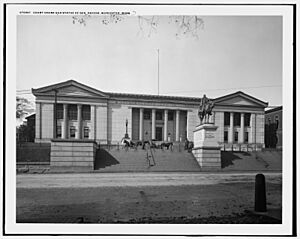
In 1950, the statue was moved a few feet during an expansion of the courthouse. Today, it stands at the corner of Main Street and Highland Street, still on the courthouse grounds. It overlooks Lincoln Square.
In 2015, the old courthouse building was sold to developers. They planned to turn it into apartments. As part of the sale, they agreed to protect the historic property, including the Devens statue. An article in 2017 confirmed that the statue would stay in its place in front of the courthouse.
What the Statue Looks Like
The monument features a bronze equestrian statue of Devens. It sits on top of a rectangular granite pedestal. Devens is shown wearing his Civil War uniform, partly covered by a heavy coat. His right hand holds the horse's reins.
The statue itself is about 25 feet (7.6 meters) tall. The granite pedestal is about 15.8 feet (4.8 meters) tall and 9.7 feet (3 meters) wide.
Inscriptions on the Pedestal
A bronze plaque on the back of the pedestal lists Charles Devens' achievements:
CHARLES DEVENS / SOLDIER, ORATOR, JURIST / 1820–1891 / MAJOR, THIRD BATTALION MASS. RIFLES / APRIL, 1861 / COLONEL, FIFTEENTH REGIMENT MASS. VOL. INFANTRY / JULY, 1861 / BRIGADIER GENERAL, UNITED STATES VOLUNTEERS / 1862 / BREVET MAJOR GENERAL, UNITED STATES VOLUNTEERS / 1865 / ASSOCIATE JUSTICE, SUPERIOR COURT OF MASS. / APRIL, 1867 / ASSOCIATE JUSTICE, SUPREME COURT OF MASS. / 1873 / ATTORNEY GENERAL OF THE UNITED STATES / 1877 / ASSOCIATE JUSTICE, SUPREME COURT OF MASS. / 1881–1891
The front of the pedestal has an inscription that reads:
TO / GENERAL DEVENS / AND THE / MEN OF WORCESTER COUNTY / IN THE WAR FOR THE UNION / 1861–1865
On the left side of the pedestal, there are names of military groups from Worcester County:
MASSACHUSETTS VOLUNTEERS / THE FIFTEENTH TWENTY-FIRST TWENTY-FIFTH / THIRTY-FOURTH THIRTY-SIXTH FIFTY-FIRST / FIFTY THIRD AND FIFTY SEVENTH REGIMENTS / COMPANIES E F AND K IN FORTY SECOND REGIMENT / COMPANIES D E F AND H IN FOURTH REGIMENT / COMPANY F IN FIRST BATTALION HEAVY ARTILLERY / MASSACHUSETTS VOLUNTEER MILITIA / THIRD BATTALION RIFLES COMPANY B WORCESTER LIGHT / INFANTRY IN SIXTH REGIMENT TENTH UNATTACHED COMPANY.
See also
 In Spanish: Estatua ecuestre de Charles Devens para niños
In Spanish: Estatua ecuestre de Charles Devens para niños
- 1906 in art
- List of equestrian statues in the United States
- List of Union Civil War monuments and memorials
- Public sculptures by Daniel Chester French


